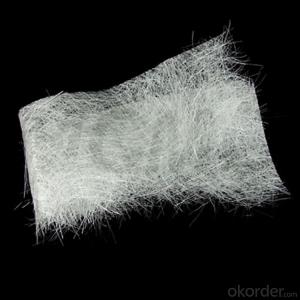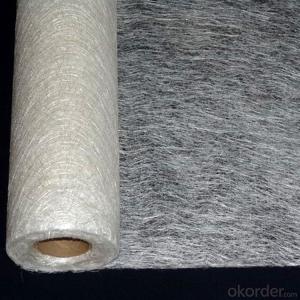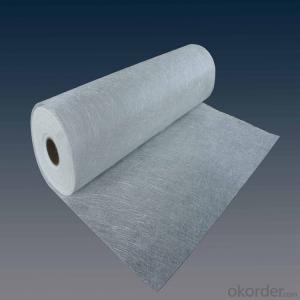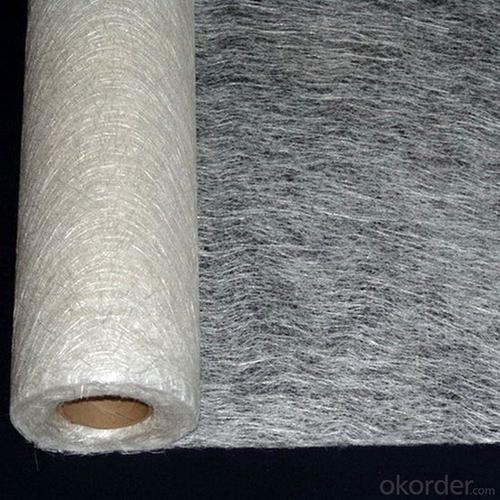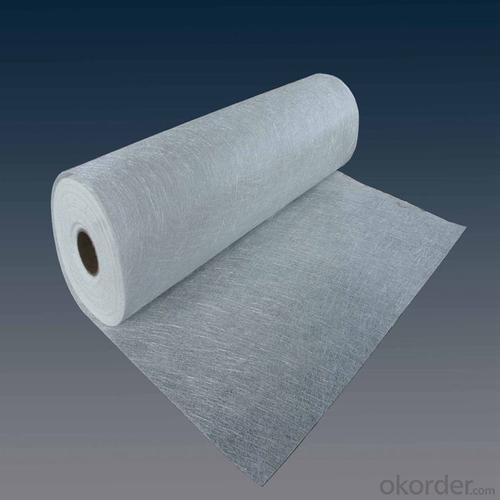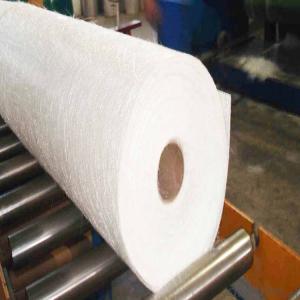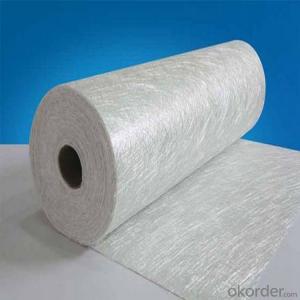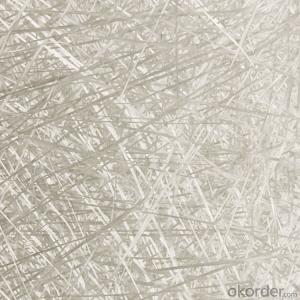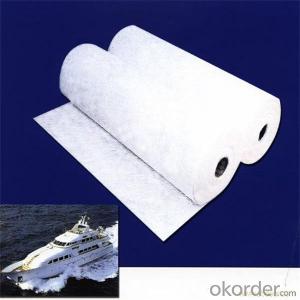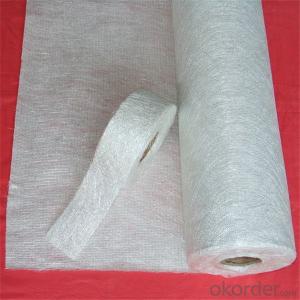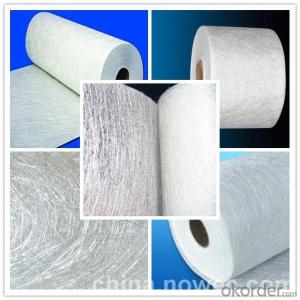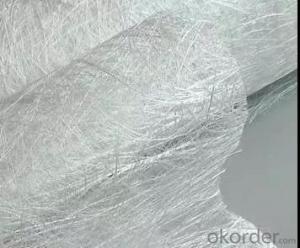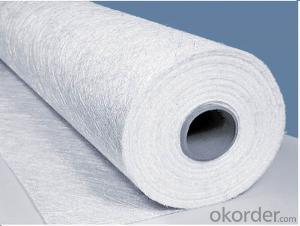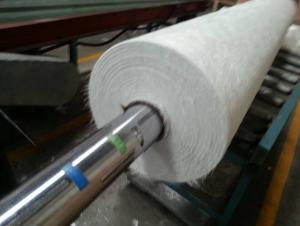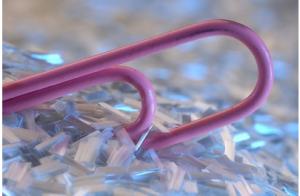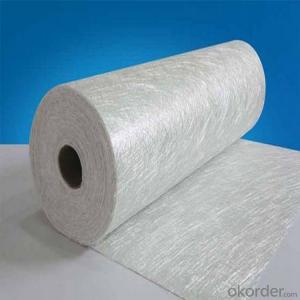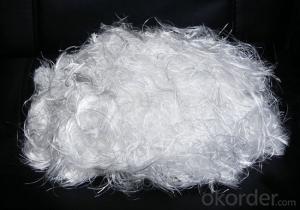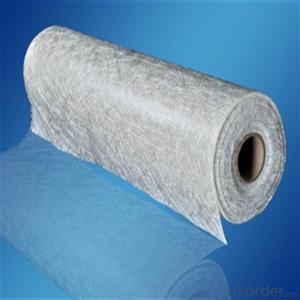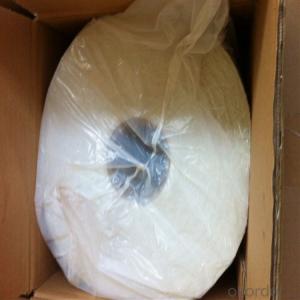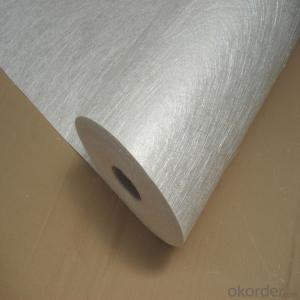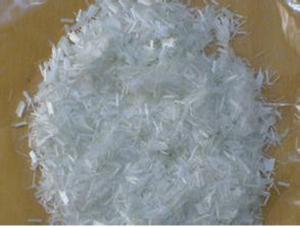High Tempreture Resistant E-glass Chopped Strand Mat for Insulation
- Loading Port:
- China main port
- Payment Terms:
- TT OR LC
- Min Order Qty:
- 1 kg
- Supply Capability:
- 5000 kg/month
OKorder Service Pledge
OKorder Financial Service
You Might Also Like
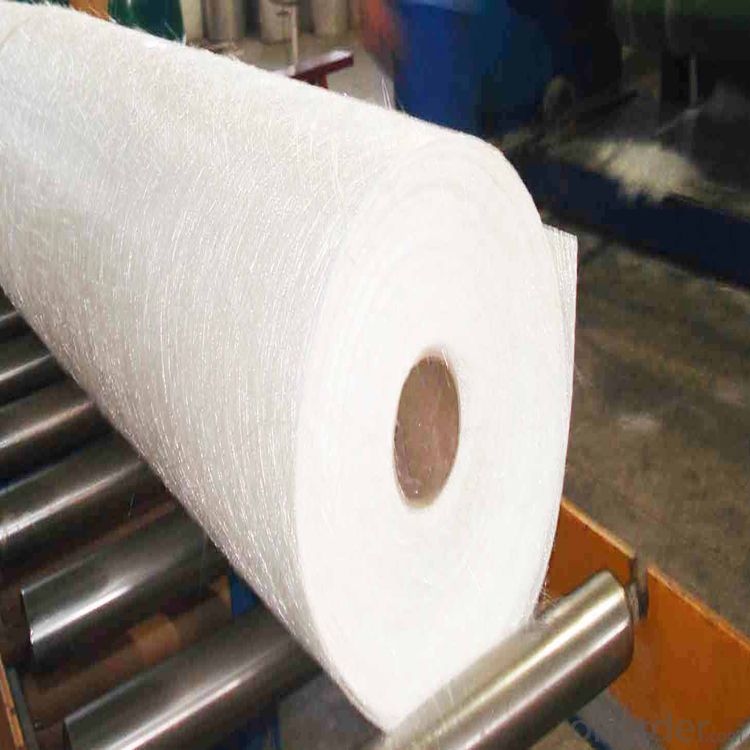
Product Description:
Fiberglass Chopped Strand Mat is fine strand reinforcement material made from E-glass cut fibers laid in a random pattern and bonded with powder or emulsion binder.
It is easy to handle and has excellent moulding performance.
Also, it has rapid resin penetration together with a fast strand wet out time.
The mat also brings a highly translucent finished laminates.
Also,the fine strand input makes the fiber prominence at the finished laminates surface extremely low.
Features
1.Excellent weight uniformity
2.Fast wet out
3.Easy air release
4.Excellent transparency of finished products
5.Excellent laminate
6.Low resin consumption
Application
1.Translucent roof panel
2.chemical storage tanks
3.FRP pipes
4.Boat hulls
5.Decks
6.Truck body panel
7.Cooling towers
8.Corrosion resistand
Specifications:
Item | Over Density | Moisture Content | Chop Density | Polyester Yarn | Width |
(g/m2) | (%) | (g/m2) | (g/m2) | (mm) | |
EMK300 | 309.5 | ≤0.15 | 300 | 9.5 | 50-3300 |
EMK380 | 399 | 380 | 19 | ||
EMK450 | 459.5 | 450 | 9.5 | ||
EMK450 | 469 | 450 | 19 | ||
EMC0020 | 620.9 | 601.9 | 19 | ||
EMC0030 | 909.5 | 900 | 9.5 |
Special products are available according to customer’s requirement.
Product Packaging:
Each Surface Tissue is wound onto a paper tube which has an inside diameter of 76mm and the mat roll has a diameter of 330mm. The mat roll is wrapped up with plastic film,and then packed in a cardboard box or wrapped up with kraft paper. The rolls can be vertically or horizontally placed. For transportation, the rolls can be loaded into a cantainer directly or on pallets.
Quantity
20'GP Container:About 10000kgs
40'HP Container:Aboout 23100kgs
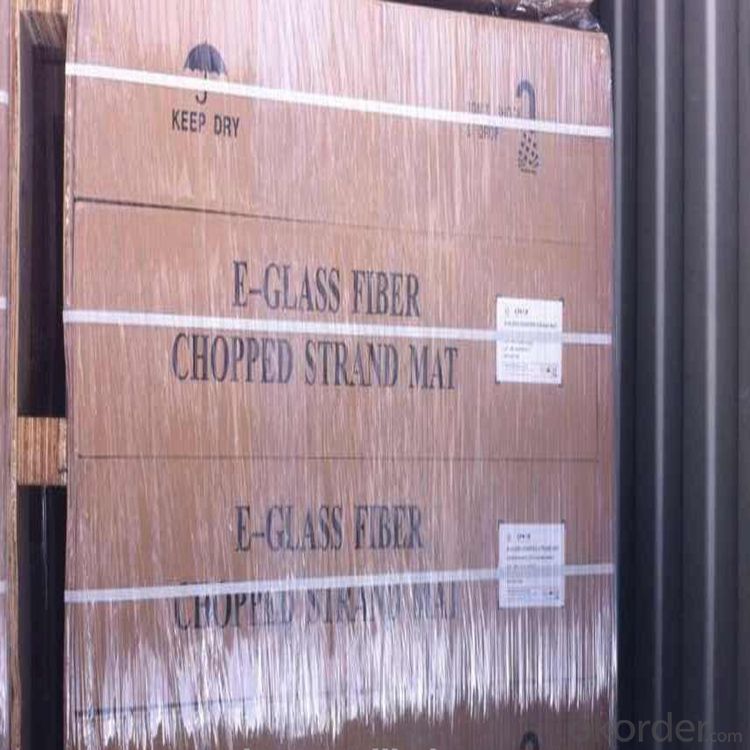
Product Storage:
Unless otherwise specified, Chopped Strand Mat should be stored in a dry, cool and rain-proof area. It is recommended that the room temperature and humidity should be always maintained at 15℃~35℃ and 50%~75% respectively.
Company Information
CNBM (China National Building Material) Group is the largest comprehensive building materials group in China that in integrate scientific research, manufacturing and logistics into one entity. The largest building materials and equipment specialists in China. Upon State Council approval, today CNBM owned more than 300 subordinate manufacturing factories and servicing companies. There are 6 fully owned public listed companies and 11 partially owned with substantial shares public listed companies. In many of these fields, CNBM is playing the leading role in the building industry in the country.

Our Service:
1.Any inquiry will be replied within 24 hours.
2.Professional manufacturer.
1) Print logo in the products;
2) The size and specification can be produce and design according to your demand.
3.High quality,fashion designs,reasonable and competitive price,fast lead time.
4.After-sale service
1) All products will have been strictly quality check in house before packing.
2) All products will be well packed before shipping.
3) All our products have 10 years rot resistance.
5.Faster delivery:sample order in stock,and 15-20 days for bulk production.
6.Payment:you can pay for the order via:T/T,Western Union,MoneyGram,L/C etc.
FAQ:
which kind of glass fiber sample and materials can you provide?
We can provide the glass fiber and glass fiber down stream products samples of E glass, C glass, ECR glass, High alkali glass. The products includes single end roving, assembled roving for different applications( Piping, SMC, panel, winding mill plate) , chop strand for BMC, engineering plastic (PA, PPA, PPT, POM, etc), chop strand mat (from 100gsm-900gsm) for automobile and water tank, etc, woven roving (270gsm-800gsm), surface tissue (25-50gsm), multi-axial fabric of different unit weight.
- Q: Does fiberglass chopped strand have any moisture resistance?
- Indeed, fiberglass chopped strand exhibits a degree of resistance to moisture. Unlike materials like wood, fiberglass naturally repels water and does not readily absorb moisture. Nevertheless, it is crucial to acknowledge that fiberglass can still undergo some level of moisture absorption over an extended period, especially if it lacks adequate sealing or coating. This may result in potential problems like delamination or weakened structural integrity. Consequently, it is advisable to employ suitable coatings or finishes to augment the moisture resistance of fiberglass chopped strand in situations where prolonged exposure to moisture is anticipated.
- Q: Can fiberglass chopped strand be used in the production of medical implants?
- Fiberglass chopped strand is not typically used in the production of medical implants. Medical implants require materials that are biocompatible, meaning they do not cause any adverse reactions or harm to the human body. Fiberglass chopped strand is made of glass fibers that may not meet the biocompatibility requirements for medical implants. It is more commonly used in industries such as automotive, aerospace, and construction. In the medical field, implants are often made from materials like titanium, stainless steel, or biocompatible polymers that have been extensively tested and approved for use in the human body. These materials have specific properties that make them suitable for implantation, such as their resistance to corrosion, ability to integrate with surrounding tissues, and compatibility with medical imaging techniques. Therefore, it is advisable to use materials specifically designed and approved for medical implant applications to ensure patient safety and optimal performance.
- Q: How is fiberglass chopped strand packaged and shipped?
- Fiberglass chopped strand is typically packaged and shipped in compressed bales or rolls. These bales are usually wrapped in protective plastic or placed in sturdy cardboard boxes to ensure safe transportation. The packaging is designed to prevent any damage or moisture exposure during shipment.
- Q: How does the creep resistance of the chopped strand affect its performance?
- The creep resistance of chopped strand is a critical factor that directly affects its performance. Creep is the tendency of a material to gradually deform under constant load over time. In the case of chopped strand, creep resistance refers to its ability to resist this deformation and maintain its shape and structural integrity. A high creep resistance in chopped strand is desirable because it ensures the material will not undergo excessive deformation or failure when subjected to long-term or sustained loads. This is particularly important in applications where the chopped strand is used as reinforcement in composites or structural components. When a material has poor creep resistance, it can experience significant dimensional changes, such as elongation or shrinkage, over time. This can lead to a loss of strength, stiffness, and overall performance of the chopped strand and the final product it is incorporated into. On the other hand, chopped strand with good creep resistance will maintain its shape and dimensions even under prolonged stress, ensuring the structural integrity and longevity of the composite or component. It will also provide better load-bearing capabilities and resistance to fatigue or failure caused by repetitive or cyclic loading. To summarize, the creep resistance of chopped strand is crucial for its performance as it directly influences the material's ability to resist deformation and maintain structural integrity under sustained loads. By choosing chopped strand with high creep resistance, manufacturers can ensure the durability, reliability, and long-term performance of their products.
- Q: What are the typical electrical insulation properties of chopped strand composites?
- Chopped strand composites typically exhibit excellent electrical insulation properties. Due to the presence of reinforcing fibers, such as fiberglass or carbon fibers, these composites have high dielectric strength, meaning they can withstand high voltages without electrical breakdown. The fibers act as barriers, preventing the flow of electric current through the material. Additionally, chopped strand composites have low electrical conductivity. This property is crucial in applications where electrical insulation is required to prevent the occurrence of electrical short circuits or leakage currents. The composite matrix, usually made of a polymer resin, helps to insulate the reinforcing fibers and reduce their electrical conductivity. Moreover, chopped strand composites offer good resistance to moisture and chemicals. This resistance is essential in electrical applications exposed to harsh environments or substances that could degrade the insulation properties. Moisture and chemicals can compromise the electrical insulation capabilities of materials, leading to potential electrical failures. Chopped strand composites, however, provide a reliable barrier against these detrimental factors. Overall, the combination of high dielectric strength, low electrical conductivity, and resistance to moisture and chemicals make chopped strand composites an excellent choice for various electrical insulation applications. These properties ensure the safety and reliability of electrical systems, preventing electrical failures and ensuring the efficient flow of electricity.
- Q: How does the fiber content of fiberglass chopped strand-reinforced composites affect their properties?
- The fiber content of fiberglass chopped strand-reinforced composites has a significant impact on their properties. Firstly, the fiber content determines the overall strength and stiffness of the composite material. As the fiber content increases, the composites become stronger and stiffer, as the fibers provide reinforcement and resist deformation under load. This is particularly important for applications where high strength and rigidity are required, such as in construction, automotive, and aerospace industries. Secondly, the fiber content affects the composite's impact resistance and fatigue life. Higher fiber content enhances the material's ability to absorb and disperse energy during impact, reducing the risk of fractures or breakages. Additionally, a higher fiber content can improve the material's resistance to repetitive loading, extending its fatigue life and making it more durable over time. Furthermore, the fiber content influences the composite's thermal and electrical conductivity. Fiberglass composites with higher fiber content tend to have lower thermal and electrical conductivity, making them suitable for applications that require insulation or electrical resistance, like electrical enclosures or insulation panels. Lastly, the fiber content affects the composite's weight and cost. Higher fiber content generally leads to a denser material, which can increase the weight of the composite. However, this increased density also contributes to its strength and stiffness. Additionally, higher fiber content often translates to higher production costs, as more fibers are needed to manufacture the composite. In summary, the fiber content of fiberglass chopped strand-reinforced composites directly influences their strength, stiffness, impact resistance, fatigue life, thermal and electrical conductivity, weight, and cost. Therefore, careful consideration of the desired properties and intended application is crucial when determining the optimal fiber content for a specific composite material.
- Q: Can fiberglass chopped strand be used in aerospace composites?
- Yes, fiberglass chopped strand can be used in aerospace composites. Fiberglass chopped strand is a common reinforcement material that is widely used in various industries, including aerospace. It offers excellent strength-to-weight ratio, chemical resistance, and thermal stability, making it suitable for aerospace applications where lightweight and high-performance materials are required. Fiberglass chopped strand can be used in the production of aerospace components such as panels, fairings, interior parts, and structural elements. It can be combined with other reinforcement materials, such as carbon fibers, to enhance the overall properties of the composite. However, it is important to note that the specific requirements and regulations of each aerospace project should be considered when selecting the appropriate reinforcement material.
- Q: What are the typical flexural strength values of chopped strand composites?
- The typical flexural strength values of chopped strand composites can vary depending on several factors such as the type of resin matrix, fiber content, fiber orientation, and manufacturing process. However, in general, chopped strand composites exhibit flexural strength values ranging from 100 MPa to 400 MPa (14,500 psi to 58,000 psi). The flexural strength of a chopped strand composite refers to its ability to resist bending or deformation under a load. This property is crucial in applications where the material is subjected to bending or flexing forces, such as in structural components or automotive parts. The specific flexural strength values can be influenced by the type of fibers used, such as glass, carbon, or natural fibers. Glass fibers are commonly used in chopped strand composites and typically provide a flexural strength ranging from 100 MPa to 200 MPa (14,500 psi to 29,000 psi). Carbon fibers, on the other hand, offer higher flexural strength values, typically ranging from 200 MPa to 400 MPa (29,000 psi to 58,000 psi), making them suitable for applications that require high strength and stiffness. It is important to note that the actual flexural strength values of chopped strand composites can vary significantly based on the aforementioned factors and manufacturing techniques. Therefore, it is recommended to consult specific material datasheets or conduct testing to determine the precise flexural strength values for a particular chopped strand composite.
- Q: How does the storage condition of fiberglass chopped strand affect its performance?
- How fiberglass chopped strand is stored significantly affects its performance. It is commonly used as a reinforcement material in different applications, including composites and construction materials. Improper storage conditions, such as high humidity or extreme temperatures, can cause the chopped strand to absorb moisture. This moisture absorption can have negative effects on its properties, including a decrease in mechanical strength, dimensional stability, and overall performance. Additionally, it can lead to the degradation of the resin matrix used to bind the chopped strand, resulting in a weaker bond between the reinforcement and the matrix. Aside from moisture absorption, improper storage conditions can also cause the chopped strands to become tangled or clumped together. This can make it challenging to achieve uniform dispersion of the fibers within the matrix during the manufacturing process. As a result, inconsistencies may arise in the mechanical properties of the final product. To ensure optimal performance, it is crucial to store fiberglass chopped strand in a controlled environment with low humidity and stable temperatures. This can be accomplished by storing the material in sealed bags or containers and keeping them in a dry and cool area. It is also advisable to use the chopped strand within a specific timeframe after opening the packaging to minimize moisture absorption. By maintaining appropriate storage conditions, the performance of fiberglass chopped strand can be preserved. This guarantees consistent and dependable outcomes in various applications.
- Q: How does the fiber-matrix interfacial shear strength distribution of fiberglass chopped strand affect the properties of composites?
- The distribution of interfacial shear strength between the fiber and matrix in fiberglass chopped strand plays a crucial role in determining the properties of composites. This shear strength refers to the ability of the fiber and matrix to resist sliding against each other, directly impacting the mechanical performance and overall behavior of the composite material. A high distribution of interfacial shear strength indicates a strong bond between the fiber and matrix, resulting in improved mechanical properties. This strong bond allows for efficient transfer of loads between the fiber and matrix, leading to increased stiffness, strength, and toughness. Consequently, the composite becomes more durable and reliable in various applications, capable of withstanding external forces and resisting deformation. Conversely, a low distribution of interfacial shear strength signifies a weak bond between the fiber and matrix. This can lead to poor load transfer and reduced mechanical properties. The weak interface may cause fiber-matrix debonding or detachment, creating localized stress concentrations and potential failure points. As a result, the composite may exhibit lower strength, stiffness, and toughness, making it susceptible to damage and failure under applied loads. Furthermore, the interfacial shear strength distribution also affects other properties of composites, including thermal and electrical conductivity, as well as resistance to moisture and chemical degradation. A strong interfacial bond facilitates efficient transfer of these properties between the fiber and matrix, enhancing overall performance. In contrast, a weak bond hinders the transfer of these properties, resulting in reduced thermal or electrical conductivity, increased vulnerability to moisture ingress or chemical attack, and overall degradation of the composite material. In conclusion, the distribution of interfacial shear strength between the fiber and matrix in fiberglass chopped strand significantly influences the properties of composites. A high distribution enhances the mechanical performance, durability, and reliability of the composite, while a low distribution can lead to reduced strength, stiffness, and toughness, as well as compromised thermal, electrical, and chemical properties. Therefore, optimizing the strength of the interfacial bond is crucial for designing composites with desired properties for specific applications.
Send your message to us
High Tempreture Resistant E-glass Chopped Strand Mat for Insulation
- Loading Port:
- China main port
- Payment Terms:
- TT OR LC
- Min Order Qty:
- 1 kg
- Supply Capability:
- 5000 kg/month
OKorder Service Pledge
OKorder Financial Service
Similar products
Hot products
Hot Searches
Related keywords
